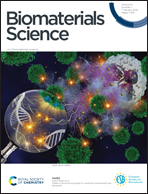Characterisation of bone regeneration in 3D printed ductile PCL/PEG/hydroxyapatite scaffolds with high ceramic microparticle concentrations†
Abstract
3D printed bioactive glass or bioceramic particle reinforced composite scaffolds for bone tissue engineering currently suffer from low particle concentration (<50 wt%) hence low osteoconductivity. Meanwhile, composites with very high inorganic particle concentrations are very brittle. Scaffolds combining high particle content and ductility are urgently required for bone tissue engineering. Herein, 3D printed PCL/hydroxyapatite (HA) scaffolds with high ceramic concentration (up to 90 wt%) are made ductile (>100% breaking strain) by adding poly(ethylene glycol) which is biocompatible and FDA approved. The scaffolds require no post-printing washing to remove hazardous components. More exposure of HA microparticles on strut surfaces is enabled by incorporating higher HA concentrations. Compared to scaffolds with 72 wt% HA, scaffolds with higher HA content (90 wt%) enhance matrix formation but not new bone volume after 12 weeks implantation in rat calvarial defects. Histological analyses demonstrate that bone regeneration within the 3D printed scaffolds is via intramembranous ossification and starts in the central region of pores. Fibrous tissue that resembles non-union tissue within bone fractures is formed within pores that do not have new bone. The amount of blood vessels is similar between scaffolds with mainly fibrous tissue and those with more bone tissue, suggesting vascularization is not a deciding factor for determining the type of tissues regenerated within the pores of 3D printed scaffolds. Multinucleated immune cells are commonly present in all scaffolds surrounding the struts, suggesting a role of managing inflammation in bone regeneration within 3D printed scaffolds.



 Please wait while we load your content...
Please wait while we load your content...